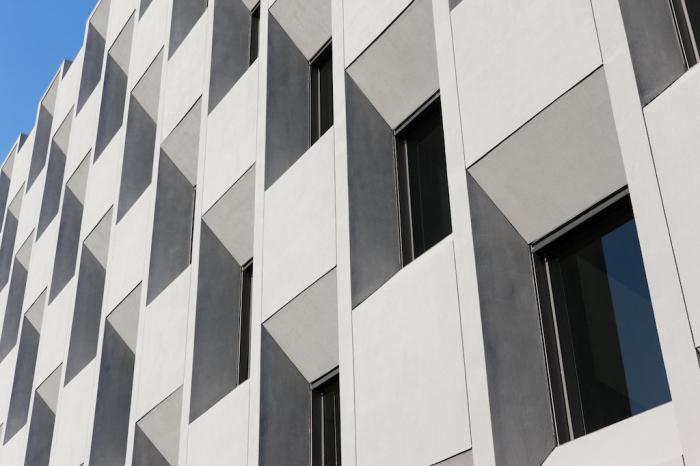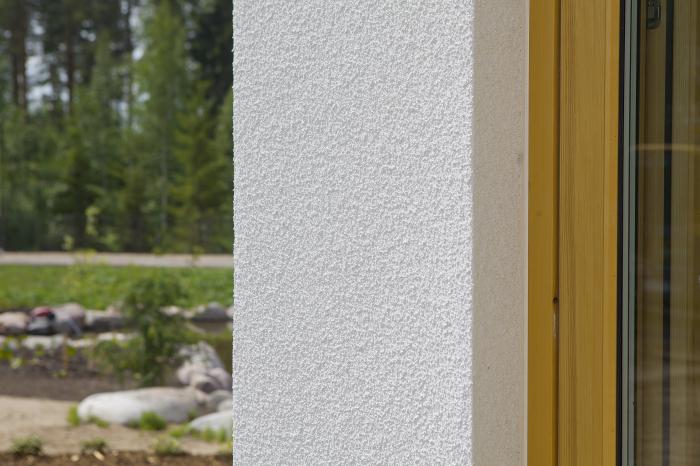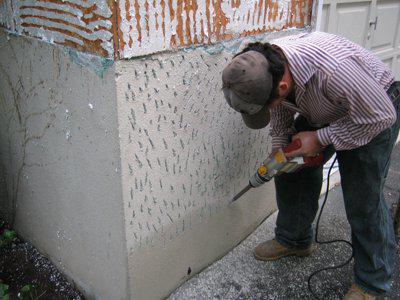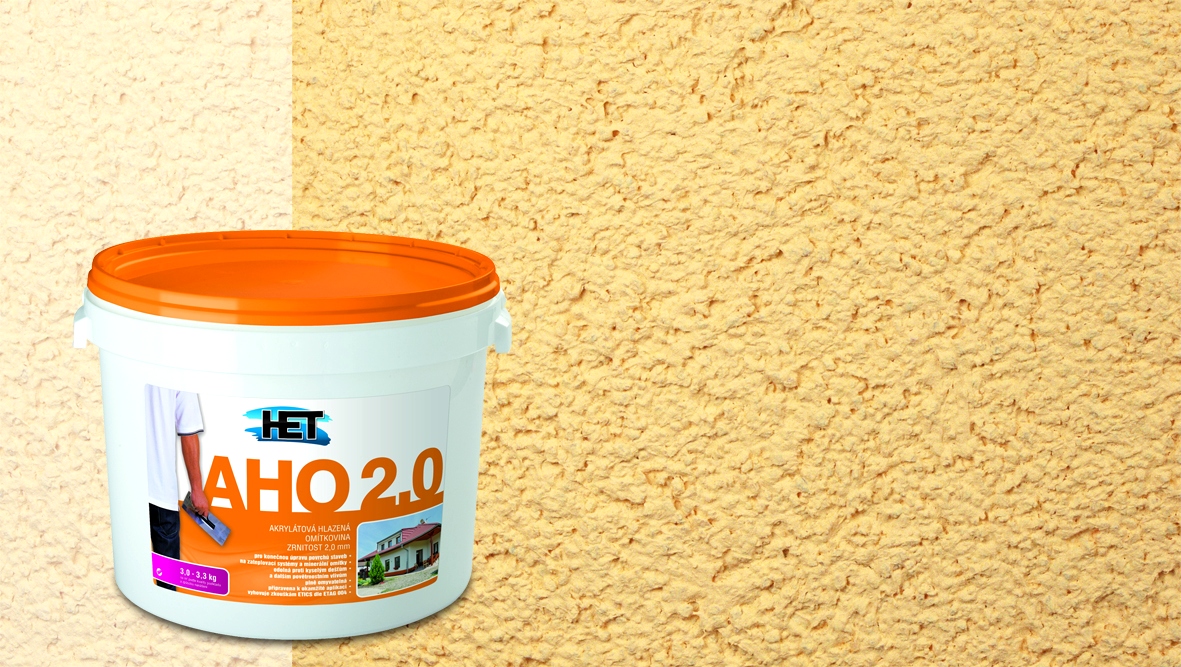External facade plaster. Which plaster is better for the facade: tips for choosing and reviews
Properly executed exterior wall decoration can radically change the style of the building, make it presentable and well-groomed. Today construction market offers plenty of variety finishing material, a significant place among them is occupied by facade plastering. Such a decoration of the building will help not only transform appearance building, but also to prevent the appearance of defects on the surface of the walls.
Finishing the facade with plaster the following benefits during operation: Types of plaster for facadesPlaster on acrylic base also called polymer. This type of plaster has elasticity and resistance to temperature fluctuations. The operational period of this material reaches 25 years. The composition of acrylic plaster includes certain biocidal additives, which protects it from various kinds of microorganisms. Also, this material is sufficiently resistant to ultraviolet rays. As a drawback of this type of plaster, one can determine its vapor impermeability, for this reason it is not recommended to use it with basalt wool. Also, acrylic plaster tends to get dirty quickly, while it is washed off by rain quite badly.
Silicate type plaster. Finishing the facade of the house with this type of plaster allows it to be used in the process of facade insulation, if the method of insulating bonding is used. The service life of the material is 25 years. Such plaster, due to its elastic structure, has good resistance to cracks. It also cleans up quite well when dirty, which allows it to have good view. However, this type of material is not recommended for use with foam lining, since the foam in this case will not breathe.
mineral plaster. Thanks to the cement in its composition, this plaster is the most durable among all types. this material and its cost is the most reasonable. It has vapor-permeable characteristics, so it can be applied over basalt insulation and foam. But the mineral type of plaster has its drawbacks. Its service life is relatively short - only 10 years. In addition, the material is not resistant to cracking and has low elasticity.
Silicone cladding compound. Such decorative plastering of the facade of the house is by far the most technologically advanced. Silicone-type plaster is elastic, vapor-permeable, has a sufficient stretch index. It is not difficult to wash off pollution from it, due to which it can be used to decorate the facades of buildings that are located near the road. But the cost of such material is quite high.
Decorative plaster. Its task is mainly to implement various design ideas. With its help, you can achieve embossed and smooth surfaces of a wide variety of shades. In addition, with the help decorative plaster you can create an imitation of more expensive types of finishes. Decorative facade plaster photo:
In order to correctly apply a layer of plaster cladding, it is necessary to take into account a number of key features process:
Preparatory workBefore you perform the process of plastering the facade with your own hands, it is necessary to perform certain preparatory actions. Let's consider them in more detail:  Technological process of finishingWhen finishing facade walls, it is very important to pay attention to the temperature of the working surface, which should be between 5 °C and 30 °C. Also on air humidity - this indicator should not exceed 70%. Remember that you should not carry out finishing immediately after precipitation, especially on time. Also, do not perform work in case of direct contact with the wall surface. sun rays. For the rest, follow the following sequence of actions:
Plastering the surface of foam concrete wallsIf you need to apply plaster lining on a foam concrete surface, you need to consider a number of such features:
Plastering concrete wallsIf the cladding surface consists of concrete slabs, it is necessary to take into account the following features plastering process:
Plastering brick wallsIn order for the plaster solution to be better attached to the brick surface, the following features of the cladding process should be taken into account:
How to plaster the facade in the video is presented below: |
Exterior decoration of buildings for any purpose may be needed not only to give the facade a more aesthetic appearance. In some cases, such work is also carried out to improve performance characteristics material. Most often recently, plaster is chosen for these manipulations, which acts as one of the most economical and practical solutions.
Features of facade plasters and consumer reviews
When choosing a material for you should prefer one that has protective functions. This is necessary so that the walls after finishing are reliably protected from negative external influences. If you are thinking about which plaster is best for the facade, then you should know that this composition must be resistant to temperature extremes. In most regions of Russia, the seasonal temperature difference is quite large, so this characteristic is of great importance. Consumers also say that moisture resistance is important to them.
Primary requirements

When purchasing plaster, you should know that the composition is able to reliably protect against precipitation and high humidity, which negatively affect unprotected bases. If you are concerned about the question of which plaster is best for the facade, then you should definitely ask if it has vapor permeability. Without this, the walls will lose their ability to release vapors from the premises to the outside, excluding the ability to breathe. If you use mixtures that do not have similar characteristics, then the inner surfaces of the walls quickly become covered with mold and rot. It is important to pay attention to the heat and sound insulation properties.
The quality of heat and sound insulation

A layer of plaster applied to the surface should create an additional barrier to the penetration of cold air and noise into the premises. Buyers note that using such mixtures, they get a comfortable microclimate in the premises of a residential building. The plaster composition should have another characteristic, which is expressed in the ease of applying the solution. If you are interested in the question of which plaster is better, the selection tips presented in the article are recommended to read.
Textures and colors

Everyone wants a home to look aesthetically pleasing, so consumers are trying to pay attention to plaster compositions manufacturers who provide a large assortment textures and colors. This allows you to create a wide variety of coatings. Low cost is also important, which goes along with excellent quality. However, you should not save, because external walls houses are exposed to negative effects that can turn the material unusable. The need for re-repair will certainly result in additional costs.
Varieties of facade plaster
 If you are thinking about which plaster is best for the facade, then you need to consider several varieties, each of which has its own properties, pluses and minuses. These characteristics are due to the difference in composition. Coatings may differ in application technology, you should pay attention to this even before purchasing the product.
If you are thinking about which plaster is best for the facade, then you need to consider several varieties, each of which has its own properties, pluses and minuses. These characteristics are due to the difference in composition. Coatings may differ in application technology, you should pay attention to this even before purchasing the product.
Features of mineral plaster
If you decide that you will use plaster for the facade, which is better, you must determine in advance. Quite often used in repair work mineral plaster. It is considered a traditional finish and is based on cement. It is loved by consumers because it is very economical.
Among the positive features of this material, high strength can be distinguished, which, among other things, increases with time. In order to give the surface the quality of moisture resistance, mineral plaster is enriched with additives.
However, it is important to pay attention to the disadvantages, one of them is expressed in a rather meager color scheme. However, after finishing the facade with such material, it can always be painted in any desired color. Such manipulations can generally be carried out at least every season.
If you are thinking about which plaster is best for the facade, then you need to pay attention to one of the most common plasters, which is called mineral. It is sold as a dry mix, which must be diluted with water before use. It is impossible to violate the proportions specified by the manufacturer. This can cause the application process to be complicated and the material to lose its performance characteristics.
Characteristics of acrylic plaster
 If you are faced with the question of which plaster is better to plaster, then you can purchase acrylic compound. It allows you to create decorative surface. All kinds of resins are used as the binding base of this mixture, while the presence special additives allows to ensure the quality of vapor permeability. Such compositions are extremely resistant to temperature variations, as well as to high humidity.
If you are faced with the question of which plaster is better to plaster, then you can purchase acrylic compound. It allows you to create decorative surface. All kinds of resins are used as the binding base of this mixture, while the presence special additives allows to ensure the quality of vapor permeability. Such compositions are extremely resistant to temperature variations, as well as to high humidity.
If there is a need to protect the building from mold and harmful microorganisms, then this composition should be chosen. Among the additives of this mixture can be all kinds of ingredients that allow you to get surfaces with interesting textures. For example, bark beetle plaster is quite common among private consumers, which imitates a base eaten away by insects. Before use, this composition must be mixed well.
Description of silicone plaster
 If you are thinking about what kind of facade plaster to buy, you should definitely read the tips that are presented in this article. Among the plasters on the market building materials, silicone mixtures can also be distinguished. They are considered the most expensive finishes, but you can be sure of their quality characteristics.
If you are thinking about what kind of facade plaster to buy, you should definitely read the tips that are presented in this article. Among the plasters on the market building materials, silicone mixtures can also be distinguished. They are considered the most expensive finishes, but you can be sure of their quality characteristics.
Among other things, this composition is considered universal. The described plaster is made on the basis of polymer compounds, which allows you to create a surface that can protect the building from all kinds of influences. At the same time, the walls will retain their original appearance. This indicates that you will not have to spend money on repairs for a long time. This is very much to the liking of private consumers who choose silicone formulations if they do not want to renew the facade in a few years.
If you are still thinking about how to choose facade plaster, the tips presented in the article will help you. So, it is worth paying attention to the fact that the silicone composition creates a surface that is characterized by excellent dirt-repellent properties, among other things, the building does not lose its ability to breathe, releasing vapors from the premises. This eliminates the occurrence of harmful microorganisms, fungus and mold. Another advantage of this finish is a wide range of colors, which allows the consumer to find any color that can match the exterior. If you have the desire and skills, you can even create facades by combining plasters different colors. Among the only drawback, only the high cost can be distinguished.
Description of silicate plaster
So, you will use plaster for the facade. Which is better? You should decide this even before going to the store. You should not make a decision until you have studied the entire range of products. It should also be noted silicate plaster, which is made on the basis of liquid glass. Such a composition has many advantages, among them excellent vapor permeability can be distinguished, due to which moisture does not linger on the surface of the walls, but freely escapes. Experts advise using this composition for finishing buildings that are built from porous materials, among which aerated concrete can be distinguished.
The mixture has the qualities of plasticity, this ensures ease of application. After drying, the coating acquires dirt-repellent properties, which is extremely important if the building is located close to the road. It is also important to decide which mesh is best for facade plastering, since it will determine the strength of the coating. It is important not to choose steel for the facade.
Plaster today is considered one of the most sought-after materials for finishing a building outside. It protects the facade from excessive heat loss. With proper repair work, it is possible to subsequently significantly save energy costs for heating a house.
It also improves the appearance of the building. wall surface after correct processing not subject negative impacts environment, not destroyed long time. Every builder or repairman should know how to properly apply plaster.
Advantages
Today it is quite high if you turn to the help of professional builders. average price such work today is about 350-400 rubles / m². Therefore, many decide to perform all the actions on their own.
Applying the presented type of finish, you can get high quality end result. First of all, it should be noted aesthetic appearance. A lot of textures, shades allows you to create a fashionable, stylish design outside of the house.
The price of which today is acceptable for almost every property owner, easy to use. Depending on the type, manufacturer of dry mixes, you can purchase a dry mix (25 kg) from 350 to 500 rubles.
The products on sale today protect walls from moisture penetration, are resistant to low temperatures prevent corrosion.
Types of plaster
Today, many varieties of mixtures for plastering facades are used. These are textured solutions that differ in a number of characteristics. The most popular manufacturers of dry mixes for such finishing are the companies KNAUF, Ts erezit". Facade plaster may contain various fillers.

To set the desired texture for the finish, the composition of the solution includes components of various grain sizes. It can be marble chips, quartz sand, colored granules, glass dust, wood fibers, etc.
Dyes are added to give color to the mixture. In this case, you can achieve almost any shade. Tinting is done in trade organization using special equipment. This allows, if necessary, to set the base to exactly the same shade, if you have to buy a dry mix. The heterogeneous structure of the solution allows you to hide the unevenness of the base.
Finishing methods
You can apply a coating on the facade of the house mechanically or manually. In the first option, you will have to purchase special equipment. Companies such as KNAUF, C erezit, facade plaster whose production is very popular today, they are developing a special line of products that can be applied mechanically to the base. This approach is preferable for professionals who perform significant amounts of finishing work.

For craftsmen who wish to apply the solution to the facade of their house, it is better to do it manually. This way you can save on the purchase of special equipment. In this case, you will need to purchase only ordinary tools. To create certain type textures, you also need to buy curly spatulas.
In the process of applying the solution in any way, the manufacturer's recommendations should be strictly followed. Only in this case it will be possible to create a strong, beautiful protective layer.
Work technology
Finishing work is carried out according to a certain technology. Properly performing each step, you can achieve good result even without experience in carrying out such actions.
Facade plaster for outdoor work, the price of which will be affordable for almost every owner of a house or cottage, designed to finish the base of different material. It can be brick, foam concrete, or other types of building materials. The most optimal and inexpensive way of finishing is the use of beacons.

The work is carried out in several stages. First you need to prepare the base, then the beacons are installed. Only after that you can start plastering the facade. This method is suitable for manual application of the solution. It is important to adhere to the proportions when mixing the dry mix, as well as the manufacturer's recommendations regarding the time of its drying.
Foundation preparation
Plastering of brick facades or made of any other materials must begin with the preparation of the base. If you skip this step or do it poorly enough, the result will be of insufficient quality.
First you need to remove old finish. It is beaten with a small hammer or a wooden block. Where the sound is deaf, the old finish is knocked out with a chisel and hammer. In some cases, you will need to use a hammer drill. It also removes dirt, oil stains and dust.
It is desirable to reduce as much as possible the number of irregularities, bumps on the base of the walls. If this is not done, you will have to apply the plaster in a thick layer. Material consumption will increase significantly. Therefore, it is better to properly prepare the surface of the walls than to spend money family budget for the purchase of additional dry mix.
A brick base requires, in some cases, jointing. This procedure allows you to increase the adhesion of the solution to the base. The plaster will hold tight, and the life of the coating will increase. Some builders during construction brick walls houses leave the facade with empty seams. This allows you to prepare the base for finishing faster.

For foam blocks, the jointing is not done. This also applies to walls reinforced concrete slabs"rough" masonry, in which the surface is smooth. A mesh for plastering facades is immediately stuffed onto such varieties of materials. First you need to apply a layer of primer deep penetration. It will enhance the adhesion of the solution to the base.
When choosing a primer, you should give preference to trusted manufacturers. It is also necessary to adhere to the correct concentration of the solution. In this case, the film will be strong.
lighthouses
Assumes the use of beacons. These are metal guides. They are installed on the base to indicate the level of plaster application. The rules, leveling the layer, slide their nose along the tops of the lighthouses.
It is believed that the use of this method of finishing allows even a non-professional to make a perfectly smooth surface. However, the master needs to familiarize himself with the technology for installing beacons on a plane.
It is necessary to determine the verticality of the wall with a plumb line. Deviations from the level must be determined before installing the guides. If the top of the walls is inclined in depth, this indicator must be taken into account. Beacons are customized to a certain size. The excess height of the guides must be cut off.
Installation of beacons
Produced after the installation of beacons. From the corner at a distance of 20 cm, a point solution is applied. Their diameter should be about 5-15 cm. The height depends on the intended layer of plastering. If the rule is 2 m long, the beacons can be placed 1.7 m apart. If the wall is too large, it is necessary to increase the guides.
Each beacon is installed in the solution and sunk a little there. The level rule is applied on top of each element. If necessary, the position of the beacon is adjusted to achieve the ideal vertical position finishes. To avoid deviations, errors, it is recommended to pull the "laces" between the two extreme elements during the alignment of the beacons. After the solution has dried, the voids formed under the lighthouse are filled with putty.
Applying the first layer
Plastering takes place in 3 stages. Facade plastering mechanized way allows you to perform all actions faster. However, in this case, be sure to work in a respirator and goggles. Otherwise, the solution may get into Airways or eyes.
The dry mixture must be diluted to the consistency of liquid sour cream. In this case, the manufacturer's recommendations must be taken into account. Ready-made ones are also on sale. Some professional builders recommend adding PVA glue to the solution. It will give extra strength. Putty will lie well on the wall.

The mortar is applied to the wall with a ladle. The mixture must be poured onto the base without pouring it. Roughness on top layer are welcome. After surface treatment, the solution must dry.
Base layer
The next step is the main facade plastering. To do this, you need to prepare a solution. It should be the consistency of thick sour cream. It is thrown on the surface between two lighthouses. It should be noted that the thickness of all layers of plaster should not exceed 5 cm.
With the narrow side, it is necessary to press the rule to the beacons. The tool is moved from side to side. The edges of the rule should not fly off the tops of the guides. The movement is made in an upward direction. The excess is cut off. This results in a perfectly smooth surface.
If during the alignment process it turned out that the solution is not enough, it should be added. The mixture is poured into the hole formed. Then again draw the rule over the surface.
Grout
Assumes the completion of the final stage. The surface needs to be sanded. This procedure is performed after the cement finish coat dries. For this, apply special graters. They can be made of foam or wood.

If a putty is used that is not based on cement, the manufacturer's recommendations should be followed. They must be indicated on the packaging.
Grouting allows you to smooth out small irregularities, seal sinks after applying the rule. The grout is performed in a spiral. Circular movements begin with wide movements, gradually moving the tool towards the center. WITH great circle the tubercle is stretched in the center. At reverse action it is completely levelled.
Considering how it happens facade plastering, everyone who wants to can do the procedure well. In this case, the surface will be perfectly flat. Following the recommendations of professional repairers and builders is a guarantee of a good result of the final work.












